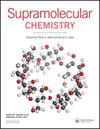Large Azobenzene Macrocycles: Formation and Detection by NMR and MS Methods
IF 2.6
4区 化学
Q3 CHEMISTRY, MULTIDISCIPLINARY
引用次数: 0
Abstract
ABSTRACT Azobenzene macrocycles are widely investigated as potential drug delivery systems and as part of molecular machines due to their photo-responsive properties. Herein, we detect the formation of a series of new azobenzene macrocycles that feature up to eight switchable repeating units. High-resolution mass spectrometry and ion mobility (IM) mass spectrometry experiments and 1H and diffusion-ordered spectroscopy (DOSY) NMR are used to detect the presence of the macrocycles that contain 10 to 40 aromatic rings in the gas phase and solution, respectively. The responsiveness of the Z-to-E photo-switching of the smallest of the macrocycles, exhibiting two azobenzene units and in total 10 aromatic rings, separated with column chromatography, is studied with irradiation experiments, using both UV-Vis light and thermal excitation and relaxation, and monitoring the sample with UV-Vis absorption and 1H NMR spectroscopy. DFT calculations are used to understand the conformation of this isolated species in solution.大偶氮苯大环:核磁共振和质谱方法的形成和检测
偶氮苯大环由于其光响应特性,作为潜在的药物传递系统和分子机器的一部分被广泛研究。在这里,我们检测到一系列新的偶氮苯大环的形成,这些大环具有多达8个可切换的重复单元。采用高分辨率质谱和离子迁移率(IM)质谱实验以及1H和扩散有序谱(DOSY) NMR分别检测气相和溶液中含有10 ~ 40个芳环的大环的存在。采用紫外-可见光、热激发和弛豫的辐照实验,利用紫外-可见吸收和1H NMR光谱监测样品,研究了最小的大环(含2个偶氮苯单元和共10个芳环)的z - e光开关的响应性。DFT计算被用来理解这个孤立的物种在溶液中的构象。
本文章由计算机程序翻译,如有差异,请以英文原文为准。
求助全文
约1分钟内获得全文
求助全文
来源期刊

Supramolecular Chemistry
化学-化学综合
CiteScore
3.60
自引率
3.00%
发文量
5
审稿时长
2.7 months
期刊介绍:
Supramolecular Chemistry welcomes manuscripts from the fields and sub-disciplines related to supramolecular chemistry and non-covalent interactions. From host-guest chemistry, self-assembly and systems chemistry, through materials chemistry and biochemical systems, we interpret supramolecular chemistry in the broadest possible sense. Interdisciplinary manuscripts are particularly encouraged. Manuscript types include: high priority communications; full papers; reviews, and; Methods papers, techniques tutorials highlighting procedures and technologies that are important to the field. We aim to publish papers in a timely fashion and as soon as a paper has been accepted and typeset it will be published in electronic form on the Latest articles section of the website. The two most important review criteria are that the paper presents high-quality work that fits generally into the broad spectrum of activities in the supramolecular chemistry field. Under normal circumstances, Supramolecular Chemistry does not consider manuscripts that would be more suitable in a highly specialized journal. This includes, but is not limited to, those based mostly or exclusively on topics such as solid state/X-ray structures, computational chemistry, or electrochemistry. .
The two most important review criteria are that the paper presents high-quality work that fits generally into the broad spectrum of activities in the supramolecular chemistry field.
 求助内容:
求助内容: 应助结果提醒方式:
应助结果提醒方式:


